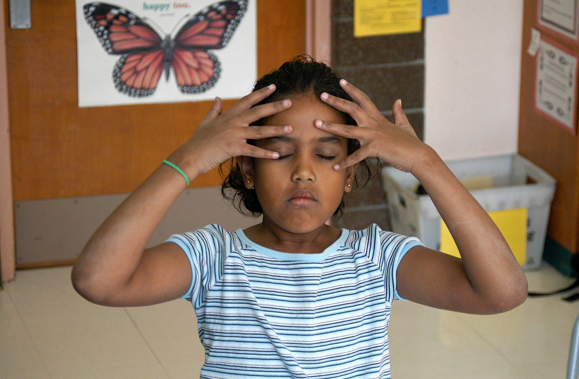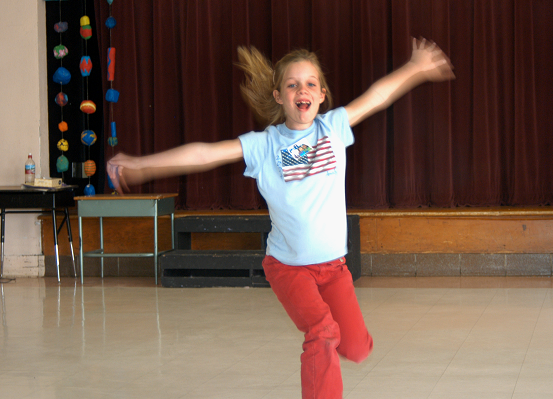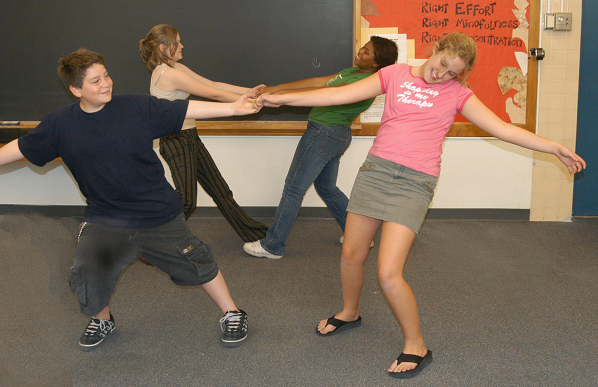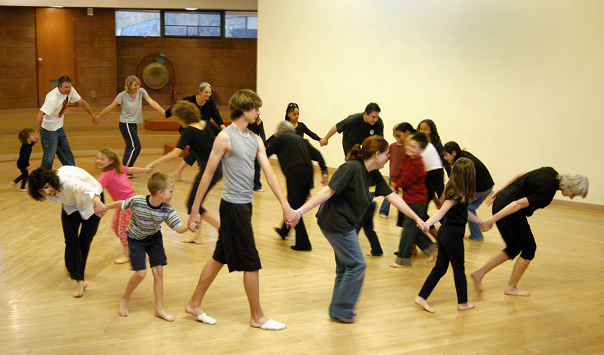Creative Dance: A Collage of Learning
Excerpt from Creative Dance and Learning: Making the Kinesthetic Link by Mary Ann Brehm and Lynne McNett. (McGraw-Hill 2008)
Chapter 3 - Creative Dance: a Collage of Learning
Why dance? The previous chapter emphasized how dance fulfils basic human needs for creating and expressing through movement. In conjunction with this primary function, creative dance promotes individual and group growth from so many standpoints that it truly is a collage of learning. Its practice can make a difference in the world. This chapter gathers and summarizes reasons why.
Creative Dance Develops Healthy Bodies
In a non-competitive atmosphere, creative dance teaches a confidence and proficiency in using the body as a tool for functional tasks, athletic competitiveness, communication, and the expressive art of dance. Moving healthfully builds self respect and boosts an individual’s physical and emotional well-being. Offering the opportunity for successful movement experiences is especially vital during physically awkward stages of development.
With sedentary activities like watching television or playing video games on the rise, it cannot be taken for granted that today’s youth receive adequate movement opportunities. In general, young people are not as active as they used to be and childhood obesity is on the rise. (Newman, 2004) Partly due to the ease modern technology affords, physical activities are less a part of normally active early years, pointing towards future potential health hazards for society. Although schools may have some sort of physical education program, it is not the case that physical activity is a part of every school day. For example only 32% of American high school students took physical education classes in 2001. (Newman, 2004) In some schools even recess time is being cut back. Creative dance can re-infuse movement into students’ lives and set the stage for life-long activity.
Creative dance is a great stress release. Relieving stress through exercise and relaxation facilitates efficient brain function and has obvious connections to mental and physical wellness. (Hannaford, 1995) Learning to modulate both tension and relaxation practices control of the body and oneself. Contraction in the muscles aids stability in movement and provides a base of strength for forceful movements. The letting go of tension aids flexibility and allows for an ease and lightness in gentle movements.
One of the many goals in dance is body awareness. Students gain awareness of the possibilities of their physical bodies as they are guided through explorations of movement. Body awareness helps one recognize healthy alignment, which aids balance and prevents injury. As students move among others, body awareness helps them to avoid accidents by being pro-active with physical self-control. Gaining awareness and trust in the body helps a person make natural and effective kinesthetic choices. This is the beginning of efficient coordination and grace.
Creative Dance Awakens the Senses
Dance provides opportunities to balance many kinds of sensory awareness. Those who work at cultivating the kinesthetic sense are paying attention to who they are, where they are going, and what they are doing. Although the kinesthetic sense is the main player in dance, the sense of sight is called upon for perceiving visual designs in movement; hearing is sensitized as movement and sound are integrated; and the tactile sense is engaged when dancers contact parts of the body, other dancers, supporting surfaces, or objects. Kinesthetic dance experience is profound in its integration with life, and is conducive to learning on many levels. The multi-sensory nature of dance contributes significantly to the critical role that movement and sensory perception play in physical and neurological development. (Hannaford, 1995) Combining other sensory awareness with the primary kinesthetic sense helps students to integrate experience and knowledge within the arts and offers diverse ways of solving problems. Movement increases students’ chances of success through activation of many sensory learning modes.

A dancer awakens the kinesthetic sense in preparation for dancing.
Creative Dance Inter-connects the Arts
Art sparks imaginations to explore and celebrate being human in an increasingly technological era. Concepts learned through creative dance build a solid foundation for understanding all of the arts: music, drama, and the visual arts. Mettler (1980) saw dance as primary and central to all the arts because all other art forms stem from movement. The throwing of a pot, the placement of fingers on a keyboard, the air flowing over vocal chords--these are results of movement. Without movement, a paintbrush would have no “stroke”, a guitar could not be “strummed”, and actors would have no physical support for their voices. Further more, each art form has an inherent relationship to dance through the Elements of movement. Dance shares the element of Time with music, and creative dance studies which emphasize time patterns and sound integrate with music. Spatial studies in dance are also design studies, sharing the Space Element with the visual arts. Dance integrates with drama through the Force Element, which calls forth emotions and the dramatic nature of interacting forces. These intrinsic connections between dance and the other art forms enable creative dance to act as the common thread when integrating the arts with each other and when infusing the arts in cross-curricular studies.
Creative Dance Exercises Thinking Skills
Harvard clinical psychiatrist John Ratey states that movement relates not only to the motor functions of the brain but “is crucial to every other brain function, including memory, emotion, language, and learning.” (Ratey, 2001, p. 148) These “higher” brain functions evolve from and depend upon movement. Why is this so? The same neural circuits that regulate physical tasks are involved in thinking processes because they involve recalling, evaluating, and sequencing actions. The brain “walks through” these actions as it remembers, plans, and makes decisions. Eric Jensen (2000) notes that movement activity is needed at fairly frequent intervals for the brain to process new information being assimilated.
Movement helps stimulate brain activity by coordinating different areas of the brain. Because the two sides of the brain control different sides of the body, contra-lateral movements (that cross the mid-line of the body or counterbalance the sides) activate neural connections between the sides of the brain. Activities such as reading and logical investigation require cross-brain integration. Brain Gym movements developed by Paul and Gail Dennison (1994) harness this connection between movement and thinking. Bonnie Bainbridge Cohen (1993) has also demonstrated how developmental movement sequences promote intellectual growth. While it may not be necessary to “dance” to allow these important nerve connections to mature, dance offers movement opportunities that stimulate and ground them. The natural movements of creative dance wake up the brain of the dancer.
As described in Chapter 10, Engaging Multiple Intelligences, (p.X), the broad ability of creative dance to exercise thinking skills can potentially tap all of Howard Gardner’s multiple intelligences. Gardner (1983) looks upon intelligence in terms of problem-solving and product-producing abilities in a variety of modes. One of the most profound intellectual values of creative dance lies in its rich opportunities for creative problem solving. Because of the exploratory nature of creative dance, the answers to problems are often unknown, and students must call upon resourceful kinesthetic thinking. There can often be several correct solutions and ways to arrive at each answer for a posed problem. People practice higher level thinking skills when they create dances for artistic expression and also when they combine dance with academic themes and concepts.
Creative Dance is Basic Communication.
Early in life, before speech, the qualities of common movements communicate expressive meaning. How a baby reaches his or her arms out--eagerly, desperately, languidly--communicates meaning without words. Even after children learn to talk, they continue to use movement to enforce their words, or as a way to say something without any words. A shrug, a hug, a wave, or a start of surprise--each express a message that can be clearly understood. Facial expressions, body gestures and postures add personality and meaning to spoken language. Body movement can also reveal contradictions to what is being said. Often movement communicates where words fail. Creative dance keeps this channel of communication alive.
When words are removed from communication, movement expression becomes especially significant. A simple action like a walk can speak eloquently. Whereas Sally’s walk has a spirited lightness to it, Anna’s may be intent and strong, while Celia’s may be stiff and awkward. The walk carries with it attitudes and subconscious habits. The unique style that a person lends to any movement, like walking, demonstrates a personal characterization. If the quality lent to movement is a conscious choice, the dancer is crafting the communication of movement feeling. Genuinely expressed feeling can evoke a feeling of kinesthetic empathy from those who are watching. When sharing dance with an audience, what the dancer communicates is movement feeling, beyond words.
Creative dance also practices the skill of effective movement communication through group work. In non-verbal leading and following studies, dancers can use movement to communicate directives to their receptive and attentive followers, who respond accordingly. The leader’s movements must be clear for the intended result to occur. These kinds of dance studies teach the importance of sensitive observation on the part of leader and follower. They are interactive, fun, challenging, and powerful in building communication skills.
Creative Dance Builds Literacy
Literacy tops the list of educational goals in the United States, probably because reading, writing and communicating are skills that further education throughout a person’s life. Dance contributes to literacy in many ways, from stimulating the brain to linking with the elements of language and composition. Examples of these are found throughout this book.
As discussed in the above section on thinking, movement is important in the development of physical/neurological skills needed for reading, writing and language. An essential neurological connection youngsters make is between movement and sight. Activation of peripheral vision, which occurs during large movements, facilitates tracking and focus of both eyes. The more the body and head move (as they do while dancing) the more the muscles of both eyes work together. Efficient eye teaming enables students to focus, track and concentrate while reading. (Hannaford, 1995) Making letters through positions and pathways in movement supports the physical act of writing. Hannaford (1995, p 81) also points out that “ease with language requires the words and proper sentence structure from the left [brain] and the image, emotion and dialect from the right. This integration allows ease of reading and writing as well as comprehension and creative access.” Kinesthetic exercises; cross lateral movements; and large motor skills like crawling, walking, running, skipping and leaping use both sides of the body and brain.
Creative dance studies engage linguistic intelligence. Some of the many creative dance activities that address literacy skills include: expressing the meaning of vocabulary words and words that exemplify phonetic rules; working with the quality of phonetic sounds and the beat of a word’s syllables; and interpreting the meaning of story characters, plot, setting and mood. Dance also provides memorable experiences that can stimulate creative and descriptive writing. The acts of composing a story, essay, or poem in written language and composing a dance with movement both involve creating a form that communicates meaning. Therefore there are many parallels between written and dance composition. See the section on Linguistic Intelligence, (p.X) in Chapter 10, Engaging Multiple Intelligences for more discussion on promoting literacy through dance. Also, Chapter 8, Linking into the Elements of Dance and the lessons of Part V provide many detailed examples of using creative dance to build literacy.

This third grader is expressing the meaning of the word “exuberant”. The movement expression indicates and anchors her comprehension of the word’s meaning.
Creative Dance Shapes Behavior and Responsibility
When teaching dance words like stability, flexibility, tension, relaxation are used in a physical context. These attributes can be applied in a social context too. Awareness of one’s body, and a knowledge of how to control it provide experience that builds confidence, coordination, and control of the whole self. Knowing that one can control and adapt movement leads one to be able to control social and emotional actions as well. Through creative dance, students learn to trust themselves and others, gaining courage to be individuals and greet the unknown. They learn to take control of their actions and their lives. Confidence mounts and creativity unfolds. From a strengthened personal awareness, individuals build self-esteem and confidence as a strong foundation for interaction with others. They are more able then to offer their full potential to society.
Laban and those who extended his work on Effort (Laban and Lawrence, 1974; Lamb, 1965; Bartenieff, 1981) into the field of psychology discovered how different movement qualities express different personal strengths. A well-balanced personality would be reflected in the ability to manifest many different movement quality combinations. Undeveloped strengths show up with a limited range of movement qualities and in the inability to respond to a given situation with the appropriate behavior. Therefore, providing students a wide variety of movement experiences proves useful for balancing behavioral attitudes and promoting healthy integrated personalities. The aggressive person benefits from practicing gentle uses of force, contained uses of space, and slow paced movements. A timid person is encouraged to open up by use of general space, large movements, and exploration of the stronger aspects of the Force Element. As a teacher, recognizing the needs of a group can guide choices for material to work with in movement. Gentle movements may serve to calm down or focus a class. Strong movements can be appropriately used to provide a group with a release of restrained energy, or to express dramatic feelings.
Creative dance builds life skills and is an excellent avenue for character building. Effort and perseverance go into mastering new skills. Usually a good deal of practice is necessary for the physical control and athletic skill summoned by a finished dance. Students polish a movement study to the point where they are pleased with it and are willing to demonstrate the dance decisions they’ve made. Even if the teacher or their peers are the only audience, performance demands excellence. Making a dance, no matter how short it is, indicates that dancers have chosen what seems to them to be the best way to communicate an idea in the form of movement. Showing dances develops confidence and demonstrates commitment. Dancers make decisions. Dancers stick to it. Dancers perform.
All creative dance lessons can affect behavior by developing both self and group awareness. Individual security and self respect found in movement activities bring strength to a group and contribute to interactive relationships. These experiences in creative movement influence attitudes and behavior, helping students to recognize appropriateness of different types of behavior in life situations.

Working cooperatively with a partner builds trust in group relationships.
Creative Dance Builds Community From Diversity
Throughout history, people have come together to dance, and to make art as an expression of their culture--a preservation, perhaps, of their heritage. The power one feels through making group art is personally satisfying and at the same time encourages a community feeling among the participants. Strong communities are made up of strong individuals. Their health depends upon the ability of an individual to bring his or her strengths forward as contribution to the larger group entity, or the ability to receive that from others.
Creative dance lessons teach individual and group skills that are needed for community building. Beginning with individual development, creative dance encourages each student to find and express his or her uniqueness. When students feel safe and individual needs are fulfilled, they are more able to accommodate group needs. Group studies in each dance element contribute to gathering a feeling of community. Dancers learn to form group bodies, they learn to accommodate their use of force in relationship to each other’s needs, they synchronize as a group on a beat pattern, and they move in spatial forms—such as a group circle or line—that create a feeling of unity. Leading and following exercises and unison movements build sensitivity to perceiving group needs and making contributions.
Pride and a sense of belonging under ride successful group work. Life skills such as cooperation and caring are developed as students create collaborative artworks with the needs of the group foremost in mind. From dancing together and contributing their own strengths to a larger entity, dancers form bonds that can last a lifetime. This provides a basis of building relationships with others in any area of life. Creative dance experience promotes the ability for working with others harmoniously at school, in the community, and in society at large.

Inter-generational dancing creates a sense of community.
Creative Dance Enriches Life
The desire to create beauty is human nature. The arts satisfy this innate need by touching one’s heart and freeing the spirit. Offering experience in creative dance, or any other art form, fosters an enjoyment of life and lifelong success factors. Art’s insistence on value helps students to value quality in all areas of experience. A sense of wonder, an appreciation of possibilities, and a persistence to finish--these are the hallmarks of art-making. They also constitute the art of living.
Creative dance lessons are fun. Enjoyment and enthusiasm are major factors in motivation and inspiration for learning and for staying in school. Like all the arts, creative dance helps prepare a person for the working world, for keeping jobs, for doing a good job. It offers opportunities for open-mindedness to many possibilities. The arts encourage students to “think outside the box” and value the creative process as a means of problem solving, and also as a way of life. It helps students integrate Creativity with thought processes, self-discipline, self-esteem, cooperation, language, communication, and self-motivation. Dance offers experience with putting theory into action to achieve a goal. It teaches the process of transferring feeling into form and creating form from abstract concepts. It develops personal awareness yet integrates one socially through group relationships and communication. Creative dance can develop a more functional, aware, and responsible human being. The integration of art, physical development, intellectual learning, and social skills make creative dance a cornucopia of fortunate opportunity for all ages, in school or out. School systems are realizing what arts educators have always known... that the arts are basic education, they enrich our lives, and are achievable by all.
Chapter Summary
Creative dance offers a wide array of crucial learning opportunities because:
• Healthy physical development depends on movement.
• Dance increases sensory awareness.
• Dance offers easy access to other art forms.
• Movement stimulates neurological development.
• Dance strengthens non-verbal communication skills.
• Neurologically and conceptually, creative dance strengthens literacy skills.
• Creative dance experiences contribute to self-control and responsibility.
• Creative dance develops skills that contribute to group work and community building.
• The artistic experience of creative dance helps students appreciate and set values for life.
Review Assignment:
Write a rationale for using creative dance within a hypothetical or real teaching situation. List reasons that speak to the physical, intellectual, emotional, social, and artistic needs of students.
